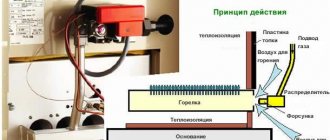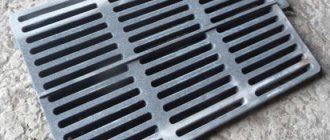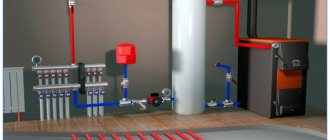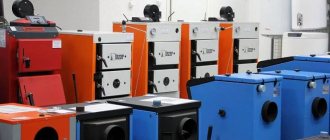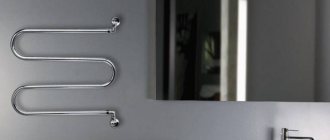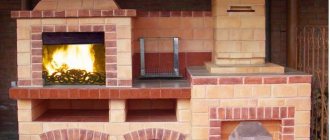Design features of the gas burner
This element of the unit creates a stable flame; it is in the burner that the fuel entering the device is burned. Then the resulting heat moves upward, where there is a heat exchanger through which the coolant liquid moves. Combustion products and excess heat escape into the atmosphere in one way or another.
The gas burner has a simple design; it consists of several main components, including:
- Nozzle – used to release gas.
- Ignition system – designed to ignite gaseous fuel.
- A sensor that monitors the presence of a burning flame.
- Automation system – monitors temperature indicators.
This is how the design looks simplified.
Modern gas burners for heating boilers are devices that must meet a number of requirements:
- Quiet operation . Is an important quality. Many consumers are familiar with Soviet-era instantaneous water heaters, in which the flame made a lot of noise. But modern models operate relatively quietly. Also, when choosing a device, you should pay attention to the ignition, since there should be no explosions or pops. The noise level is additionally affected by the design of the combustion chamber.
- Long period of operation . In older models of gas units, the burners worked for a long time, since at that time the equipment was made to last. Nowadays such technologies are not used, so these elements installed in gas boilers break down quite often. In this case, experts recommend purchasing devices manufactured under well-known brands, for which they use high-quality components. You should not buy Chinese equipment of unknown manufacture and cheap domestically produced boilers, since they often have short-lived burners installed.
- Complete combustion of gaseous fuel . This is an important requirement, since the burner must burn natural gas completely with minimal release of combustion products and other associated compounds, including carbon monoxide. The degree of combustion is also affected by other components. We should not forget about arranging high-quality gas removal - for this you need to make a chimney that has good draft.
The operating principle of a gas burner is simple:
- The unit detects the presence of a discrepancy between the temperature in the heating circuit and the indicators specified by the equipment users.
- After opening the gas valve, fuel enters the burner.
- At the same time, the ignition system is activated.
- Once the gas is ignited, a flame appears.
At the same time, the flame sensor starts working, which monitors its presence: if the fire suddenly goes out, the automation shuts off the fuel supply. Once the heating system reaches the required temperature, the gas supply stops.
Manufacturers implement the function of monitoring the presence of flame in burners in different ways. In some units, a simple thermocouple is installed, and electronic-based automatic boilers are equipped with an ionization control system.
Choosing the best option
When choosing a gas burner, do not forget about the nuances.
The simplest, naturally aspirated torch burners are well suited for tourism. Even cheap Chinese products that you don’t really mind breaking or losing will help you light a fire or heat up food. For everyday life and minor repairs, amateur series tools are preferred
The design of semi-professional burners is more complex, and there are no shortcomings in it, such as, for example, melting of the plastic lining of the mouthpiece or failure of piezo ignition. An additional argument against average prices is the almost universal absence of a normal control valve, which can also be important in the case of rough work. If you plan to use the device for delicate work, soldering or welding, additional attention should be paid to balancing and ergonomics. These jobs involve frequent switching on and off of the burner; therefore, the shape of the housing and the placement of the controls should allow one-handed ignition and adjustment.
The choice of power is dictated by the thickness and material of the workpieces.
Burners with a power of 500-700 W are quite suitable for soldering copper wires or burning paint. Steel products and tubes made of non-ferrous metals up to 3 mm thick can be heated well with a burner with a power of about 1200-1500 W. 2-3 kW burners are used for heating and bending reinforcement up to 14 mm thick. And about one more feature: the flame of high-quality, powerful burners can be adjusted for more delicate work, but it will not be possible to heat a massive part with a low-power burner.
Types of gas burners
For a long time, only simple, non-automated boilers without complex electronics were presented on the heating equipment market in the country. They required the installation of full-fledged chimneys, and placed them in well-ventilated rooms. Today there are devices on sale that operate in almost any conditions. Traditional models are being implemented alongside them.
There are the following types of burners:
- atmospheric;
- closed type;
- with a burning igniter;
- with electronic ignition.
How to clean
Over time, gas burners require cleaning and maintenance. If the equipment contains a fine filter, it must be cleaned or replaced. If there is no filter, then you need to clean the nozzles, in which dust, dirt and oily substances that enter them with the gas accumulate.
Cleaning is carried out with compressed air, but only if its pressure does not exceed that allowed for this type of burner, or simply with a stream of air. The nozzles can be cleaned with medium-hard polymer brushes with short bristles, but special cleaning compounds that soak up any dirt and easily come off without damaging the base work better.
Output nozzles often become clogged due to dirt and dust entering with the air. Dirt should be cleaned either with special cleaning agents, a soap solution, or in a dry state with a stream of air and a medium-hard brush.
Atmospheric burners are easy to clean. All elements are quite easy to disassemble and are available even for self-cleaning, without the involvement of a specialist. Inflatable burners must be sent for maintenance (maintenance) only at service centers or on site by a foreman, if it is possible to call him to your home.
Atmospheric burners
The presence of an atmospheric burner significantly simplifies the design of heating devices. Such devices operate as a result of the natural flow of oxygen, and chimneys are installed to remove combustion products. Since oxygen is taken from the room, it is necessary to provide high-quality ventilation.
The advantages of boilers with an atmospheric gas burner are as follows:
- A simple design device, which has a positive effect on the cost of the equipment.
- Low noise level. There are no additional fans in the device, only the roar of the flame is heard.
- High degree of reliability. Since the device consists of a minimum number of components, it rarely breaks down.
- Energy independence. Since the operation of the unit does not depend on the availability of electricity, it can be used in homes where the power supply is turned off.
There are also negative points:
- Low efficiency. Boilers with closed burners have a more advanced design, they are more efficient and economical.
- Mandatory installation of a chimney, which must be brought to the roof, which entails additional financial costs.
- The boiler should be installed under a gas burner in a room specially designed for this purpose, where there is a window and ventilation, and such requirements are sometimes problematic to fulfill.
The possibility of incomplete combustion of gaseous fuel cannot be ruled out either.
Models
The most popular manufacturers of gas burners are the following companies: Thermor, Niorot, Bartolini and Hyundai. And the first gas burner was created in Germany back in 1933. That is why manufacturing companies from this country still occupy leading positions in this niche.
The most common models of gas burners can be noted.
Inexpensive but high-quality model from. Capable of heating an area of up to 18 m², the control type is mechanical. The cost of such a device is within 1 thousand rubles.
Depending on the manufacturer, type and availability of additional capabilities, burners differ from each other in dimensions, design and technical characteristics. The choice depends solely on the capabilities of the buyer, as well as the potential purpose of the device.
Closed type burners
Currently, heating equipment is equipped with closed burners. Such boilers are called “turbocharged”. Their operation requires the installation of compact chimneys, which are often installed directly outside the wall when the house is just being built. In this case, the creation of ventilation ducts and a chimney system is greatly simplified.
A boiler equipped with a closed combustion chamber is a heating unit in which a gas burner is placed in a special chamber. Oxygen enters it from the outside through a coaxial chimney. It also removes products formed during fuel combustion.
All flows in the coaxial chimney are controlled by a powerful fan, in which the speed is regulated automatically. It is a structure consisting of pipes of different diameters. They are placed one inside the other.
A similar chimney serves to take in air and remove combustion products. They bring it out through a nearby wall, maintaining a distance of half a meter from the window openings; sometimes more stringent requirements are imposed on installation.
Gas appliances with closed burners have a number of advantages:
- Possibility of placement in rooms for different purposes - in the kitchen, in the bathroom, in the basement and even in the bedroom.
- Ensuring increased safety, since the fuel burns in a completely isolated chamber. If the gas suddenly goes out and the automation does not work, the gas-air mixture will be removed outside the building or room.
- High efficiency rate. Units with a closed burner type are more efficient, but this circumstance does not apply to all boiler models.
- Effective temperature control, for which they use a fan shaft speed control system.
- Environmental friendliness - gas burns almost completely.
There are also disadvantages:
- Complex device - a closed gas burner for a household boiler has a complex design, which will complicate repair work.
- Reduced degree of reliability. The greater the number of parts, the more often the equipment breaks down.
- High price. A “turbocharged” unit costs 10–15% more than its naturally aspirated counterparts.
- Increased noise level, which depends on the selected modification. The fan built into the system makes a loud noise.
- Energy dependence. In the event of a power outage, the equipment stops working. Purchasing an uninterruptible power supply will help solve this problem.
Despite the presence of the above disadvantages, these types of boilers are quite in demand among consumers. Closed-type burners are equipped with condensing units, which are characterized by high efficiency due to the use of heat released by combustion products.
Popular varieties
Now let's look at the most common models.
With soldering attachment
This device is intended for heating medium-sized parts, as well as for compact soldering. This occurs due to heating from the sting flame. Such a torch can easily be called a soldering iron without wires. The gas reservoir has a capacity of 8 milliliters. When filling with butane, the flame temperature is 1300 degrees, and the tip temperature is 450. The flame length can be adjusted within 4-6 centimeters. The diameter of the burner is 1.5 centimeters and the length is 13 centimeters.
The price of this model is approximately 400 rubles.
Advantages:
- easy refueling;
- presence of a nozzle for contact soldering;
- the refill is enough to seal several medium-sized parts;
- low price;
- compactness.
Disadvantages: there is no piezo ignition.
Micro burner
There is nothing in this device except a nozzle with a gas supply regulator and a tank with a filling valve. It does not have piezo ignition and is supplied unfilled. In this regard, you will have to additionally purchase a gas can (can be used for lighters). Such a burner is enough to heat heat shrink or solder two wires without a soldering iron. The weight of such a device is 43 grams, and the length is up to 20 centimeters.
The price of the equipment is 200 rubles. This is the cheapest device of this type.
The advantages are the following parameters:
- easy refueling;
- the lowest price.
Flaws:
- there is no piezo ignition;
- the gas station runs out quickly;
- the flame is small.
Mini soldering iron KVT XZ-1
This is a remarkable device from a brand that produces gas equipment. It has piezo ignition. The set includes: 4 soldering tips, a tip cleaning sponge, and a solder spool.
For contact soldering, the stated power of the soldering iron is 137 W. For a soldering iron weighing 120 grams and 21 centimeters long, this is a lot. Electric soldering irons have never even dreamed of such weight and size characteristics. This soldering iron is not positioned as a torch, but it can be used in this capacity - the flame comes out like a pencil.
The price of such equipment is 2300 rubles.
Disadvantages: high price.
Advantages:
- high thermal power;
- good case;
- there is a set of components;
- convenient for soldering;
- famous brand.
Iris Barcelona
This type of equipment is intended for repairing jewelry and electronic equipment, welding and soldering. Its flame is adjustable. You can refill with a regular gas cylinder, which is intended for lighters. The flame can reach a length of up to 3 centimeters, and the temperature can reach 1300 degrees. It can work for approximately 20 minutes. The length of the device is 20 centimeters.
Such a device costs 1,500 rubles.
Advantages:
- brand;
- presence of piezo ignition;
- small dimensions.
Disadvantages: the flame does not allow processing large and medium-sized parts.
Butane torch KVT X-220
Intended for repair and construction work. Looks stylish. The handle is corrugated and pleasant. The flame ignition system is piezoelectric. The capacity of the cylinder for highly purified butane is 22 millimeters. This volume of gas is enough for 110 minutes of continuous operation. The flame reaches a length of 3-8 centimeters, and its shape is adjustable from wedge-shaped sharp to soft with yellow tongues. The device is 14 centimeters long and weighs 226 grams.
Such a device costs approximately 1,600 rubles.
But the advantages are:
- comfortable handle;
- presence of piezo ignition;
- presence of a stand;
- is a good option for desktop work.
Flaws:
- You can’t get into a narrow place;
- large dimensions. Because of this, it will not fit in your pocket.
Variety of burners by ignition type
The simplest method of ignition is considered to be with a wick - with a burning igniter. When the automation is triggered, the gas is ignited with a wick, after which the device begins to heat the liquid. There are two negative aspects to this - increased fuel consumption and an insufficient degree of safety, since the igniter may go out. Primary ignition is performed with matches or using a piezoelectric element.
The second method is electronic ignition in a gas appliance - it is provided by a high-voltage converter, the energy for which is supplied by electricity or batteries. Read also: “How a gas burner for a stove works - types, advantages of use.”
The first method is used in non-volatile devices - they do not have electronics, and the second option is when automatic gas burners are used for heating boilers. In this case, in addition to electronics, flame ionization control modules are installed on board.
Different types of fuel can be used to ignite the burner. The natural gas supplied from the main line is purer; it is supplied at optimal pressure, so the flame in the device does not smoke. Such boilers are connected to the network without making any modifications.
There are burners on sale that can operate on propane. This will require reconfiguring the system and installing the nozzle. When burned, the flame gives off a yellow glow, and there is an increased deposition of soot on the walls of the chimney. The jets normalize the propane pressure to a normal value; they are supplied as a kit or purchased.
General rules for installing a chimney for a stove
Another condition for the normal operation of a gas stove is the installation of a chimney. For gas-fired stoves, smoke channels must be vertical, without ledges. The design of the chimney of a wood-burning stove is often not suitable for the removal of gas combustion products.
The slope of the chimney is allowed, but not more than 30°, and provided that the cross-section of pipes on inclined sections is not less than the cross-section of pipes installed vertically
You can refurbish an old chimney by lining it. Upgrade options:
- Installation of a stainless steel pipe in the chimney duct. In this case, the diameter and height of the pipe should be selected according to the characteristics of the chimney duct. The gap between the walls of the chimney and the pipe is filled with non-flammable heat-insulating material such as expanded clay or foam glass.
- Application of FuranFlex technology. The method involves placing an elastic polymer tube inside the channel, which, under pressure, takes its shape and hardens. The protective layer serves to insulate, seal and internally protect the chimney.
If none of the chimney modification options work, you will have to install a new one. Depending on the location of the stove, two options for installing a chimney are possible: an external attached one or an internal one.
The influence of the characteristics of the chimney on the safety of heating is such that it will necessarily be checked by the Fire Inspection authorities with the subsequent issuance of a written certificate, without which the equipment will not be connected to gas networks.
Burners for universal equipment
Gas burners intended for solid fuel heating boilers have a complex design. They are intended for converting heating appliances from one type of fuel to another. Thanks to the special design, after purchasing a universal unit that runs on wood, when a gas main appears in a populated area, it can be converted to operate using natural gas.
They produce automatic gas burners for solid fuel appliances in accordance with the fan circuit. After supply, the gas is mixed with air, and then the prepared fuel-air mixture is sent to the nozzle. Here it is ignited, and a flame of high temperature is formed.
An automation system, a powerful fan, a special filter and a gearbox are mounted on board the gas burner. For the unit to function, a power supply is required. The device itself has a modular (removable) design.
An example of such a device is a product for Cooper boilers. The device itself is pellet, but it can be converted to natural or liquefied gas if a replacement burner is connected to it.
Homemade units
Some craftsmen make gas burners for boilers with their own hands (for solid fuel boilers). Please be warned that this is not safe. And no one will allow you to connect such a structure to the gas main. Most often, such “crafts” are made on the basis of some gas units that have spent their time. Remember that a homemade gas burner for heating your home is far from the best option. It is best to purchase the simplest gas non-volatile boiler and convert it to bottled gas.
With your own hands
The easiest way to make the first type of burner, since it can be made from scrap materials.
To make it, you will need to use the following materials (almost all of them are available):
- The valve from an empty oxygen cylinder (it will serve as a nozzle here). What kind of valve it will be is not at all important; you can use the most common VK-74.
- In order for the gas stream to be directed as narrowly as possible , you will have to build a small cap that will be placed on the valve. Carefully make a small hole in it and place a jet there (a part from a blowtorch would be perfect).
- The injector will be the simplest - it will require a steel pipe, the thickness of which will not be higher than 2 mm. It is better to make it about 100 mm in length. The most reliable way to secure it is by welding. However, in this case, you will have to maintain a certain distance that should remain between the cap and the nozzle. This is done to ensure that a sufficient amount of fresh air enters there.
- To ensure that the flame ignites quickly , a piezoelectric element is installed next to the nozzle. You can do without it, and light the burner with matches and a piece of paper.
Blitz tips
- Recently, combination burners have been gaining popularity. These are some of the safest structures, but at the same time they are very complex. Their efficiency is quite high, but the price also makes itself felt.
- The burner of a gas boiler should be cleaned if the gas consumption in the room begins to noticeably increase, if there is some kind of unpleasant odor, if, despite all the indicators remaining unchanged, the air temperature in the heated room begins to noticeably decrease.
